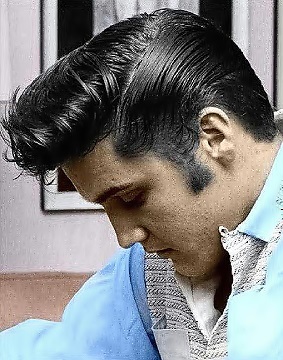Limited First Edition: 100 copies
Paul Belard's Elvis - The Gospel Singer continues his chronological visual record of the Elvis story, only this time it is subject specific, Elvis’ love for and recording of gospel songs. A simple but effective page design with a neat twist, makes the book easy to read both visually and narratively.
The Visual Element
The many, many visuals are a pleasing mix in color and b&w. The quality is essentially very good with a few historic archival images, not surprisingly a little grainy or dark. They range across album covers, in the studio, Elvis live on stage in his gold suit during the 50s and his jumpsuits in the 70s, off-stage relaxing, and with fans.
Some of my favorite visuals were:
- colorised images of Elvis live on stage in Cleveland on October 19, 1955;
- a neat “action” mosaic over two pages of Elvis live at the Shrine Auditorium in Los Angeles in 1956;
- a set of images from August 1957 of Elvis with the Sunshine Boys;
- several colorised images of Elvis with his little finger in a cast after breaking it during a game of touch football in 1960; and
- Elvis backstage at the Gospel Quartet Convention Memphis in 1970.
Belard has cleverly presented double page sets of images on colored pages (the various colors include black pale blue, yellow, blue and orange) to give extra emphasis to the photos. One stand out is page 216 where the blue page with white text lyrics for Amazing Grace accentuates an image of Elvis from Aloha From Hawaii.
A value add is the chapter The Records which presents 24 pages of color covers for many Elvis singles, EPs, vinyl albums and CDs from around the world. There were many I had never seen before. Each cover is cited by its title, country of origin and date of release.
The Narrative Element
The author includes more text than usual in Elvis The Gospel Singer. The narrative element includes accounts of Elvis’ recording sessions including The Million Dollar Quartet jam session, His Hand In Mine in October 1960, How Great Thou Art session in 1966 at RCA’s famous Studio B in Nashville and the He Touched Me album recordings. The book also includes information about Elvis’ gospel influences as well as his various backing singers and groups......from The Blackwood Brothers and The Golden Gate Quartet to The Rambos (Dottie, Buck and Reba) and JD Sumner and the Stamps.
Many readers will delight at reading about figures including the celebrated Black Gospel composer, the Reverend William H. Brewster, who led the choir in the East Trigg Baptist Church which Elvis joined as a teenager,
and Mama Cass Elliot's meeting with Elvis.
The archival material includes a substantial excerpt from a fascinating article by Phil Tate about Elvis and gospel music which originally appeared in a publication called The Messenger.
Belard also provides the lyrics for each of Elvis’ gospel recordings. Some readers may wonder about a number of the songs, and while they may seem unusual they are rightful inclusions, for example, I Got A Feelin' In My Body, Bridge Over Troubled Water, All My Trials and Battle Hymn of the Republic.
The author has informed EIN that one image is out of place. The photo on page 151 is not from the 1960s, but the 1950s.
Verdict: Elvis The Gospel Singer is another engaging release from Paul Belard. With an impressive 316 pages chock full of information and visuals it will please many fans, especially those with a particular interest in Elvis’ non-secular recordings.
 |
Paul Belard's Objective: Paul Belard's publishing objective is to effectively do what has been done by other author’s in a dominantly narrative form, by presenting the Elvis story (close to day by day) in a predominately visual format. In this respect, he has already released seven volumes with another 40 near completion!
Belard's books are not trying to compete with the wonderful coffee-table releases from authors such as Erik Lorentzen (The Elvis Files series), rather they fill a different niche as Belard wants to offer a comprehensive chronological set of images telling the Elvis story. Accordingly, the visuals are not taken from the original negatives and there are a number of low quality images, presented due to their historical significance and/or rarity.


